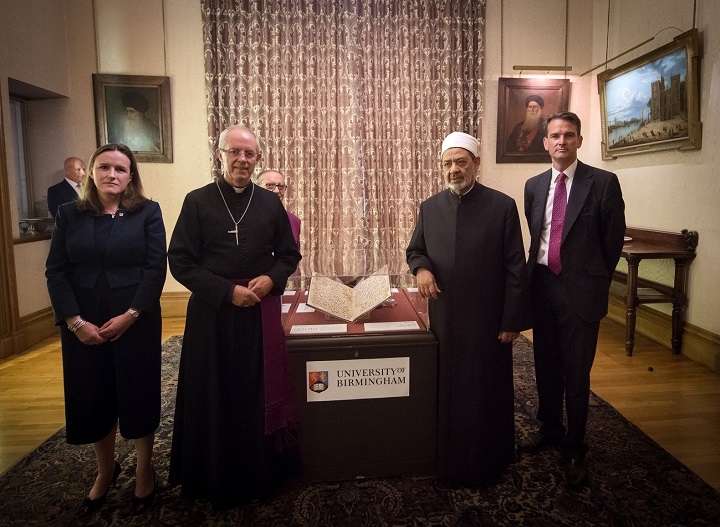
The University of Birmingham displayed the Birmingham Qur’an to the Grand Imam of Al-Azhar and the Archbishop of Canterbury, in a private viewing of the ancient manuscript in London.
The two faith leaders examined the iconic Islamic manuscript in a special viewing at Lambeth. One of the oldest surviving Islamic manuscripts, the Birmingham Qur’an is considered a global treasure.
The manuscript has been radiocarbon dated to 568 to 645 AD and experts have concluded that it may have been written by someone who had either seen, or knew personally, the Prophet Muhammad.
There was also an opportunity for the Grand Imam and the Archbishop to examine one of the most significant Coptic manuscripts in the University’s collection - a Christian manuscript for the consecration of a Coptic church in Egypt. The Christian manuscript dates from 1308 AD.
During the private viewing, experts from the University’s Cadbury Research Library discussed the significance of the Birmingham Qur’an and the wider Mingana Collection of Middle Eastern manuscripts to people of all faiths, and for the study of Islam in particular.
Following the private viewing for the Grand Imam and the Archbishop, Cadbury Research Library experts guided representatives of the Christian-Muslim Forum, as well as a number of Muslim and Catholic students, through the stories behind both manuscripts.
Professor Robin Mason, Pro-Vice-Chancellor (International) of the University of Birmingham, who welcomed the faith leaders to the viewing, said: “The Birmingham Qur’an manuscript is of huge significance to people of all faiths, and especially the scholarly study of Islam. We are immensely honoured to be the stewards of such a treasure at the University of Birmingham.
“In the spirit of deepening inter-faith understanding and dialogue, we are honoured to offer the Grand Imam of Al-Azhar and the Archbishop of Canterbury an opportunity to appreciate this extraordinary manuscript and our wider Mingana collection of historic Middle Eastern manuscripts.
“The University of Birmingham plays a key role in advancing dialogues between major faiths. We are proud of our wider research in and engagement with these faiths, and the opportunities we create that help to connect leaders from faith communities around the globe.”
University representatives, led by Professor Mason, discussed the work of the University's Edward Cadbury Centre in enhancing public understanding of religion regionally, nationally and internationally. The Centre deepens understanding of major faiths through its scholarly work and engagement with faith communities.
The Birmingham Qur’an exhibition formed a highlight of the UK/UAE 2017 Year of Creative Collaboration, held under the patronage of HH Sheikh Mohammed bin Zayed Al Nahyan, Crown Prince of Abu Dhabi and Deputy Supreme Commander of the UAE Armed Forces, and HRH The Prince of Wales.
Thousands of visitors explored the Birmingham Qur’an’s history when the University’s interactive digital exhibition toured the UAE in 2017 and 2018, visiting Sharjah, Abu Dhabi and Dubai.
For more information, please contact Tony Moran, International Communications Manager, University of Birmingham on +44 (0) 121 414 8254 or +44 (0)782 783 2312.
- The University of Birmingham is ranked amongst the world’s top 100 institutions, its work brings people from across the world to Birmingham, including researchers and teachers and more than 6,500 international students from over 150 countries. Founded in 1900, it was England’s first civic university, where students from all religions and backgrounds were accepted on an equal basis.
- The Birmingham Qur’an manuscript is a remarkable fragment of history. Part of the University’s Mingana Collection of Middle Eastern manuscripts, it consists of two leaves containing parts of Suras (chapters) 18 to 20 and dates back to the seventh century. It is written in Hijazi, an early form of Arabic script.
- When the manuscript was revealed to the world in July 2015, the University trended on Twitter, with the story reaching over 450 million people worldwide. It was covered in every major national and international publication.
- In October 2015 the manuscript went on public display in the University's Bramall Music Building. Over the course of the three-week period, nearly 9,000 people visited campus to see the Birmingham Qur’an, with people coming from as far away as China, New Zealand, Zimbabwe, Sweden and Malaysia.
- The uniquely rich Mingana Collection contains over 3,000 Middle Eastern manuscripts (approximately 1,000 of which are Islamic) covering a range of subjects including science, medicine, mathematics, astronomy, philosophy, and religion. The Collection was brought together in the 1920s and 1930s under the direction of Birmingham businessman and philanthropist Edward Cadbury. His vision was to create, in Birmingham, one of the greatest theological manuscript libraries in the world, “not for selfish ends, but as a trust for scholars all over the world”. The Collection has been designated as being of ‘Outstanding International Importance’.
- The Edward Cadbury Centre works in Birmingham, one of the UK’s most diverse and multi-faith cities, to explore the role of religion in public life and in building cohesive communities in the city. It works across the UK to promote a ‘factoring in faith’ pledge by which policymakers and policy networks will consider the impact of their work upon faith communities. It engages internationally, for example by helping development and refugee NGOs better understand the needs of faith communities.